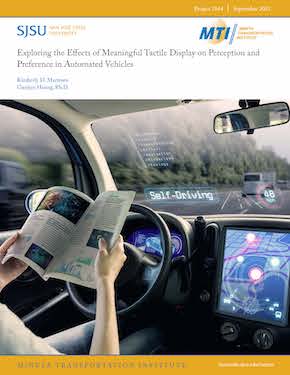- 408-924-7560
- mineta-institute@sjsu.edu
- Donate
Exploring the Effects of Meaningful Tactile Display on Perception and Preference in Automated Vehicles
There is an existing issue in human-machine interaction, such that drivers of semi-autonomous vehicles are still required to take over control of the vehicle during system limitations. A possible solution may lie in tactile displays, which can present status, direction, and position information while avoiding sensory (e.g., visual and auditory) channels overload to reliably help drivers make timely decisions and execute actions to successfully take over. However, limited work has investigated the effects of meaningful tactile signals on takeover performance. This study synthesizes literature investigating the effects of tactile displays on takeover performance in automated vehicles and conducts a human-subject study to design and test the effects of six meaningful tactile signal types and two pattern durations on drivers’ perception and performance during automated driving. The research team performed a literature review of 18 articles that conducted human-subjects experiments on takeover performance utilizing tactile displays as takeover requests. Takeover performance in these studies were highlighted, such as response times, workload, and accuracy. The team then conducted a human-subject experiment, which included 16 participants that used a driving simulator to present 30 meaningful vibrotactile signals, randomly across four driving sessions measuring for reaction times (RTs), interpretation accuracy, and subjective ratings. Results from the literature suggest that tactile displays can present meaningful vibrotactile patterns via various in-vehicle locations to help improve drivers’ performance during the takeover and can be used to assist in the design of human-machine interfaces (HMI) for automated vehicles. The experiment yielded results illustrating higher urgency patterns were associated with shorter RTs and higher intuitive ratings. Also, pedestrian status and headway reduction signals presented shorter RTs and increased confidence ratings compared to other tactile signal types. Finally, the signal types that yielded the highest accuracy were the surrounding vehicle and navigation signal types. Implications of these findings may lie in informing the design of next-generation in-vehicle HMIs and future human factors studies on human-automation interactions.
KIMBERLY D. MARTINEZ
Kimberly is a Graduate student in the Department of Industrial and Systems Engineering in the Human Factors and Ergonomics Program at San Jose State University. She received her Bachelor’s degree in Cognitive Science from the University of California, Santa Cruz in 2019, where she focused on human-computer interaction and artificial intelligence. Her interests lie in understanding and improving the way people perceive and interact with technology, while needing to make decisions and problem solve under pressure. She is currently working towards becoming a human factors researcher in the domain of autonomous vehicles and accessibility.
GAOJIAN HUANG, PHD
Dr. Huang joined San Jose State University as an Assistant Professor in the Department of Industrial and Systems Engineering in Fall 2021. Currently, he is the Director of the Behavior, Accessibility, and Technology Lab. He is also a Research Associate in the Mineta Transportation Institute and a Faculty Affiliate in the Center on Healthy Aging in Multicultural Populations at San Jose State University. He received Master’s degrees in Cognitive Psychology from Purdue University and in Safety Management from Indiana University Bloomington in 2020 and 2016, respectively, and obtained his Ph.D. in Industrial Engineering from Purdue University in 2021.
-
Contact Us
San José State University One Washington Square, San Jose, CA 95192 Phone: 408-924-7560 Email: mineta-institute@sjsu.edu






